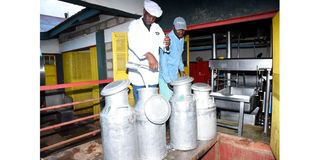Milk shortage: Cooling, processing plants idle amid low supply

Reuben Rono (left), an employee at Tarakwo Dairies in Tarakwo, Uasin Gishu County does quality check on milk delivered by farmers, where they have majored in Milki yoghurt and Milki Lala production on September 28, 2021.
What you need to know:
- Milk cooling plants are receiving less than 2,000 litres, down from 10,000, as farmers complain about high production costs.
- Some processors are struggling to repay loans.
- Milk prices have increased by an average of Sh12, from Sh48 to Sh60 per litre, hurting consumers.
Most milk cooling and processing plants are counting losses running into millions of shillings due to a decline in supply caused by prolonged drought.
Milk deliveries have dropped by almost half due to a shortage of animal feeds, prompting plant managers to scale down operations to cut costs.
“The biting drought has impacted negatively on milk production. We no longer receive steady supply of the produce from farmers, which has affected our operations,” said David Kiptoo of Lelgaa Dairies in Nandi County.
High production costs
The milk cooling plant receives less than 2,000 litres, down from 10,000, as farmers complain about high production costs.
“The low milk supply works against the economies of scale, considering that we still have to chill the low quality of milk supplied, meet high electricity costs and pay workers,” Mr Kiptoo said.
He said some processors are struggling to repay loans.
“We have renegotiated with our creditors on how to repay our loans or risk having our assets auctioned in the event that we default,” he added.
Loans
Most dairy farmers service their loans with money from their milk deliveries.
“The low milk deliveries as a result of the drought have reduced our income and ability to service loans. The low return means farmers will not access loans to improve their breeds and milk supply,” said Reuben Kosgei, of the Saos Farmers’ Cooperative Society in Nandi.
Milk prices have increased by an average of Sh12, from Sh48 to Sh60 per litre, hurting consumers, who must now dig deeper into their pockets to afford the precious commodity.
Most retail outlets in the North Rift have limited supplies of milk, with consumers not allowed to purchase more than two packets in some shops.
Dry spell
But some dairy farmers who stocked enough silage to withstand fodder supply shortages during the dry spell are still supplying milk to processors.
“I set aside part of the maize crop to produce enough silage to cushion my dairy animals from any shortage of feeds,” said Willy Kosgei, from Chepkanga, Uasin Gishu County.
Most of these farmers produce silage from maize, sorghum or wheat produce.
Most traders in the region have increased the prices of animal feeds due to high taxation on inputs.
“The scarcity of hay during the dry spell pushes up the prices, with a bale that was going at Sh100 selling for Sh250, an increase that reduces milk production by half,” said Julius Lagat, from Saos in Nandi.
Farmers said it costs them Sh22 to produce a litre of milk, apart from other expenses, and better prices will transform the sector into a profitable investment.
Most dairy farmers in the North Rift have invested in modern production techniques, following support from the Ministry of Agriculture and Livestock and development partners.
Dairy farmers in Uasin Gishu, for instance, earned about Sh3 billion from over 186 million litres of milk last season. That was largely the result of the ministry’s Smallholder Dairy Commercialisation Programme, which has enabled farmers to develop sustainable dairy businesses.
The programme empowered farmers’ groups to set up milk cooling plants, and cut post-harvest losses from contamination of dairy products caused by poor storage facilities.
New KCC
Dairy farmers have cited the slow reform process at the New Kenya Cooperative Creameries (New KCC), which was supposed to act as a market stabiliser and cushion them from exploitation by private processors who offer low prices in peak season.
“It is unfortunate that New KCC is not running smoothly, years after efforts started to salvage it from administrative and financial challenges, letting the private sector run show,” said James Maiywa, from Chepkumia, Nandi.
The Kenya Dairy Board (KDB) last year announced plans to regulate milk prices to protect farmers against exploitation by processors.
Artificial Insemination
But dairy farmers in the North Rift want the government to subsidise the cost of artificial insemination (AI) to improve the quality of animal breeds and increase milk production.
They say high costs of AI services offered by private breeders were compromising the quality of dairy breeds as they cannot afford the charges.
“The exorbitant cost of AI services has forced most farmers to resort to using bulls to breed their animals, which compromises quality,” said James Tuwei, from Nandi County.
The North Rift has an estimated 1.2 million dairy cows and between 400,000 and 500,000 heifers.
A report from the Ministry of Agriculture shows that Kenya produced an average of 4.2 billion litres of milk last year, against the potential of 12 billion, due to poor animal husbandry techniques used by most farmers.





